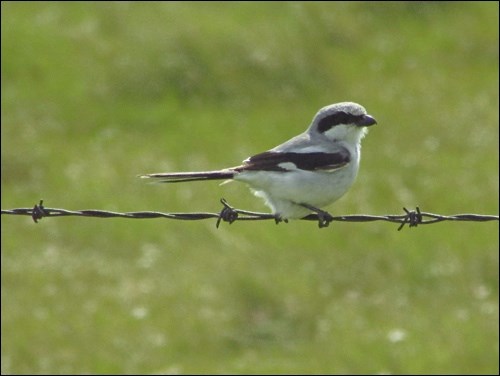Be on the lookout for loggerhead shrikes (aka butcherbirds) perching on fence posts, barbed wire, or dead branches in shrub patches and shelter belts; especially around abandoned farmsteads.
These threatened migratory songbirds have returned to prairie farmlands for the breeding season from their winter vacation in southern Texas and Mexico.
Any parent will know when you have four children they’re hungry, all the time. Loggerhead Shrike chicks are no different and the parents are constantly on the search for food. These birds are natural pest controllers and feed on insects as well as rodents such as mice and voles. They have even been observed eating snakes. But why is a songbird eating prey that a hawk would?
The loggerhead shrike is an almost perfect mix of songbird and bird of prey. They are small bodied and excellent flyers but also have a sharp, hooked beak for tearing off pieces of prey. Unlike hawks and other birds of prey, the Shrikes don’t have talons to hold onto their prey while they eat it.
“Loggerhead shrikes hang their prey, much like your neighbourhood butcher would. They use anything they can to hang it on, but most commonly barbed wire and thorny shrubs,” says Ashley Fortney, the co-ordinator of Shrubs for Shrikes at Nature Saskatchewan.
“This allows them to hold their prey while they eat and is also how they got their nickname.”
Loggerhead shrikes are slightly smaller than a robin and have a distinctive black eye “mask” and contrasting white patches on their wings and tail. They have a grey back, white under parts and black wings, as well as a black hooked beak. When alarmed shrikes give a distinctive high pitch shriek, but also have a series of harsh calls and “clacks.”
“Loggerhead shrikes nest in thorny shrubs such as hawthorn or buffalo berry, in shelterbelts, farmsteads, golf courses and cemeteries. Our Shrubs for Shrikes program works with landowners who voluntarily conserve these nesting habitats for the shrikes,” explains Fortney.
“Nature Saskatchewan is asking anyone who sees a loggerhead shrike, or hanging prey on barbed wire or thorny shrubs, to call the toll-free HOOT line at 1-800-667-HOOT (4668),” she says.
“By reporting sightings to Nature Saskatchewan’s Shrubs for Shrikes program you are helping to monitor the population, and provide valuable information for the conservation of species at risk in Saskatchewan. Personal information provided is never shared without permission,” adds Fortney.



